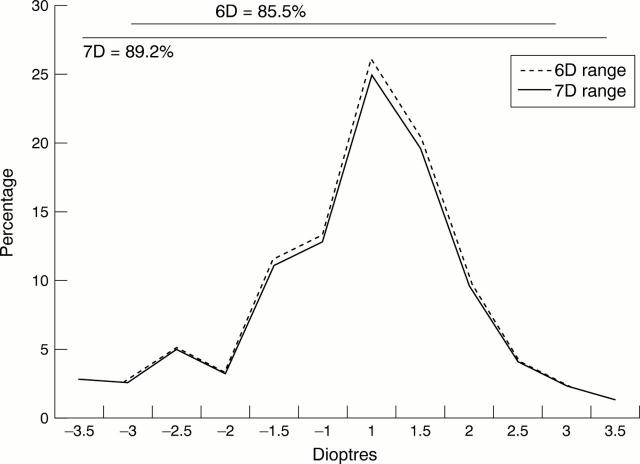Abstract
AIMS—To assess the feasibility of providing a stock of ready made spectacles for correction of refractive error in the general population. METHODS—Data were collected in the Visual Impairment Project, a population based survey of Victorian residents aged 40 years or older in randomly selected urban and rural sample areas. This included a refractive eye examination and the proportion of subjects with hypermetropia, emmetropia (defined as −1.0 to +1.0D spherical equivalent), and myopia documented in the 40-60 year age group. RESULTS—2595 (54.8%) participants were aged between 40 and 60 years. Those with a best corrected visual acuity of less than 6/12, astigmatism of more than 1.25D, and anisometropia of more than 0.5D were excluded. 516 participants had refractive error which was deemed suitable for correction by "off the shelf" spectacles. This represents 19.9% of all participants between 40 and 60 years of age. Provision of spectacles in 0.5D increments would provide suitable stock spectacles for 85.5% of a −3.0 to +3.0D range or 89.2% of a −3.50 to +3.50D range. CONCLUSIONS—Ready made "off the shelf" spectacles could significantly alleviate visual morbidity due to refractive error in up to 20% of an urban population in Australia. This approach may also be useful in developing countries with poor access to optometric services.
Full Text
The Full Text of this article is available as a PDF (121.3 KB).
Figure 1 .
Participants eligible for "off the shelf" spectacles.
Figure 2 .
Refractive error versus percentage of subjects. Broken line: 6D range (−3.0 to +3.0). Solid line: 7D range (−3.5 to +3.5). Proportion of ametropic population across 6D or 7D range outlined above.
Selected References
These references are in PubMed. This may not be the complete list of references from this article.
- Attebo K., Mitchell P., Smith W. Visual acuity and the causes of visual loss in Australia. The Blue Mountains Eye Study. Ophthalmology. 1996 Mar;103(3):357–364. doi: 10.1016/s0161-6420(96)30684-2. [DOI] [PubMed] [Google Scholar]
- Bailey I. L., Lovie J. E. New design principles for visual acuity letter charts. Am J Optom Physiol Opt. 1976 Nov;53(11):740–745. doi: 10.1097/00006324-197611000-00006. [DOI] [PubMed] [Google Scholar]
- Dandona L., Dandona R., Srinivas M., Giridhar P., Vilas K., Prasad M. N., John R. K., McCarty C. A., Rao G. N. Blindness in the Indian state of Andhra Pradesh. Invest Ophthalmol Vis Sci. 2001 Apr;42(5):908–916. [PubMed] [Google Scholar]
- Klein B. E., Klein R., Lee K. E., Cruickshanks K. J. Performance-based and self-assessed measures of visual function as related to history of falls, hip fractures, and measured gait time. The Beaver Dam Eye Study. Ophthalmology. 1998 Jan;105(1):160–164. doi: 10.1016/s0161-6420(98)91911-x. [DOI] [PubMed] [Google Scholar]
- Klein R., Klein B. E., Linton K. L., De Mets D. L. The Beaver Dam Eye Study: visual acuity. Ophthalmology. 1991 Aug;98(8):1310–1315. doi: 10.1016/s0161-6420(91)32137-7. [DOI] [PubMed] [Google Scholar]
- Klein R., Klein B. E., Moss S. E. Age-related eye disease and survival. The Beaver Dam Eye Study. Arch Ophthalmol. 1995 Mar;113(3):333–339. doi: 10.1001/archopht.1995.01100030089026. [DOI] [PubMed] [Google Scholar]
- Liou H. L., McCarty C. A., Jin C. L., Taylor H. R. Prevalence and predictors of undercorrected refractive errors in the Victorian population. Am J Ophthalmol. 1999 May;127(5):590–596. doi: 10.1016/s0002-9394(98)00449-8. [DOI] [PubMed] [Google Scholar]
- Livingston P. M., Carson C. A., Stanislavsky Y. L., Lee S. E., Guest C. S., Taylor H. R. Methods for a population-based study of eye disease: the Melbourne Visual Impairment Project. Ophthalmic Epidemiol. 1994 Dec;1(3):139–148. doi: 10.3109/09286589409047222. [DOI] [PubMed] [Google Scholar]
- Maul E., Barroso S., Munoz S. R., Sperduto R. D., Ellwein L. B. Refractive Error Study in Children: results from La Florida, Chile. Am J Ophthalmol. 2000 Apr;129(4):445–454. doi: 10.1016/s0002-9394(99)00454-7. [DOI] [PubMed] [Google Scholar]
- Pararajasegaram R. VISION 2020-the right to sight: from strategies to action. Am J Ophthalmol. 1999 Sep;128(3):359–360. doi: 10.1016/s0002-9394(99)00251-2. [DOI] [PubMed] [Google Scholar]
- Sperduto R. D., Seigel D., Roberts J., Rowland M. Prevalence of myopia in the United States. Arch Ophthalmol. 1983 Mar;101(3):405–407. doi: 10.1001/archopht.1983.01040010405011. [DOI] [PubMed] [Google Scholar]
- Tielsch J. M., Sommer A., Witt K., Katz J., Royall R. M. Blindness and visual impairment in an American urban population. The Baltimore Eye Survey. Arch Ophthalmol. 1990 Feb;108(2):286–290. doi: 10.1001/archopht.1990.01070040138048. [DOI] [PubMed] [Google Scholar]
- Weih L. M., VanNewkirk M. R., McCarty C. A., Taylor H. R. Age-specific causes of bilateral visual impairment. Arch Ophthalmol. 2000 Feb;118(2):264–269. doi: 10.1001/archopht.118.2.264. [DOI] [PubMed] [Google Scholar]
- Wensor M., McCarty C. A., Taylor H. R. Prevalence and risk factors of myopia in Victoria, Australia. Arch Ophthalmol. 1999 May;117(5):658–663. doi: 10.1001/archopht.117.5.658. [DOI] [PubMed] [Google Scholar]
- Wong T. Y., Foster P. J., Hee J., Ng T. P., Tielsch J. M., Chew S. J., Johnson G. J., Seah S. K. Prevalence and risk factors for refractive errors in adult Chinese in Singapore. Invest Ophthalmol Vis Sci. 2000 Aug;41(9):2486–2494. [PubMed] [Google Scholar]
- Zhao J., Pan X., Sui R., Munoz S. R., Sperduto R. D., Ellwein L. B. Refractive Error Study in Children: results from Shunyi District, China. Am J Ophthalmol. 2000 Apr;129(4):427–435. doi: 10.1016/s0002-9394(99)00452-3. [DOI] [PubMed] [Google Scholar]




